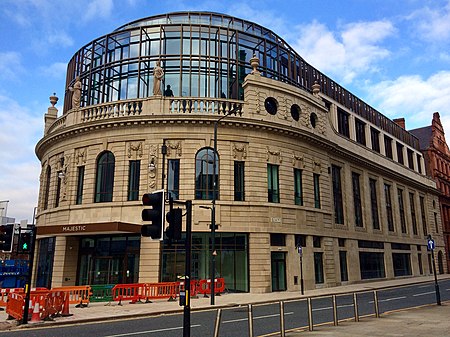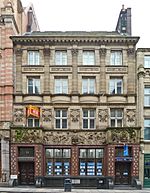Majestic, Leeds
1922 establishments in EnglandChannel 4Former cinemas in EnglandGrade II listed buildings in LeedsGrade II listed cinemas ... and 5 more
Leeds Blue PlaquesListed commercial buildings in the United KingdomMovie palacesTheatres completed in 1922Use British English from September 2020

The Majestic is a Grade II listed building on City Square, Leeds, occupying the corner of Quebec Street and Wellington Street.Constructed as a cinema in the early 1920s during a boom in the building of picture palaces, it was closed in 1969, after which the Majestic was used as a bingo hall and later as a nightclub. The building was listed at Grade II in 1993 as the Top Rank Bingo Hall and, in 2014, was badly damaged in a fire, resulting in the loss of all original interior and roof. Subsequently, it has been redeveloped into offices by Rushbond, serving as the national headquarters of Channel 4.
Excerpt from the Wikipedia article Majestic, Leeds (License: CC BY-SA 3.0, Authors, Images).Majestic, Leeds
Quebec Street, Leeds Holbeck Urban Village
Geographical coordinates (GPS) Address Nearby Places Show on map
Geographical coordinates (GPS)
| Latitude | Longitude |
|---|---|
| N 53.796388888889 ° | E -1.5488888888889 ° |
Address
Channel 4
Quebec Street
LS1 2HA Leeds, Holbeck Urban Village
England, United Kingdom
Open on Google Maps











